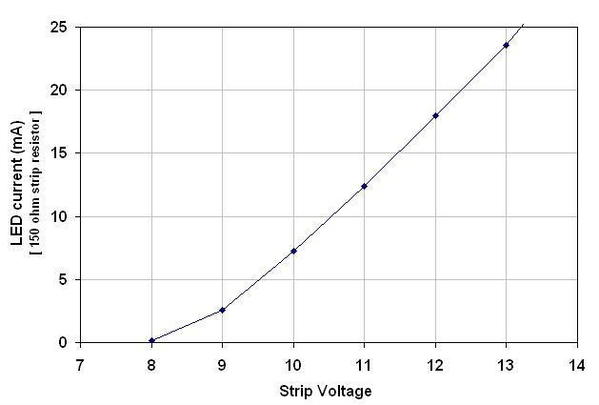I was referring to the 5 meter reels of 5050 LEDs. They seem to operate fine on 12V DC but they are way too bright...
If you are using 5m LED reels, and they are "way too bright" I'd guess you probably need to cut the brightness in half to start. LEDs have the interesting property that brightness as measured in light output is exactly proportional to current. Double the current, double the brightness. Halve the current, halve the brightness. Here's a plot from one section (3-LEDs) of a strip from an earlier thread showing the current vs. voltage relationship.

In this case, you apply 12V DC and it turned out to be about 18 mA of current. So to cut the brightness in half (to about 9 mA current) you'd need to apply just above 10V DC. This kind of gives you an idea of the voltage range you need to manage; in other words no point in going below 8V since there will be no current and hence no light at all.
The other comment that others have made perhaps indirectly is do you really need a 10 Amp power supply? A typical 5m LED strip is 100 cut-able sections of 5cm length with 3-LEDs per section. At 12V DC, each section draws about 20mA so the total strip draws 2000mA or 2 Amps. That's 300 LEDs. So 10 Amps could drive 5 full strips or 1,500 LEDs!!! I'm not questioning the value of having current in reserve, but do you really have that big a layout?! And if applying 12V DC is "way too bright" and you dial your power source down to 10V DC (or so) to cut the current in half, that same 10 Amp power supply can now drive 3,000 LEDs!!!
So you have many options. Since you'd be using the bench supply at 12V DC (or less), you really are buying a 12V, 10 Amp supply. That's 120 Watts or about 50 cents per Watt. Yes, it's all in one neat tidy package, but as mentioned previously you can get fixed-output 12V DC bricks (wall-warts) for closer to 10 cents per Watt. Then you can use low-cost DC light-dimmer modules to chop this voltage down to between 8-12V DC and lower the overall cost. Everyone has their opinion on building lighting but I think having a bit more control over different buildings, areas, etc. is worth the extra wiring of multiple knobs/controls...rather than just one global control knob controlling all of those thousands of LEDs. You can then use the money you save and buy a 3 Amp (or whatever) bench variable supply to "test components" on the bench.









